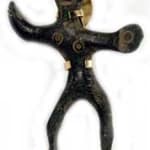Celtic Bronze Figure of a Rider, 500 BCE - 500 CE
Bronze-Gold
1.5
FJ.6726
This Ancient Sculpture Has Been Set in a Modern 18 Karat Gold Pendant. When we speak today of 'Celts', we mean people who live on the very western edges of...
This Ancient Sculpture Has Been Set in a Modern 18 Karat Gold Pendant.
When we speak today of 'Celts', we mean people who live on the very western edges of Europe, in Ireland, Wales, Cornwall, Scotland and Brittany. The word comes from Keltoi, the name which the Greek authors of the 5th century B.C. and later gave the native people of Western Europe from Spain to the former Czechoslovakia. The Celts also spread into Britain, Northern Italy, and parts of Asian Turkey. They were known to the Romans as the Gauls, but would have thought of themselves not as one people, but as different tribes. Celtic tribes at different times were Rome's enemies, allies and, once conquered, the soldiers, farmers and craftsmen of much of its empire.
Celtic art has its origins in the sculpture, carving and metalwork of the ancient Celtic peoples who dominated Continental Europe and the British Isles from about 1000 B.C. onwards before becoming submerged in the growing Roman Empire. Only in Britain and Ireland did the Celtic traditions survive.
This mysterious little bronze figure of a rider was probably originally attached to a steed, evident from the flattened underside in between his bowed legs. Incised lines decorate the body, representing his facial features, hair, fingers, and various markings along his chest, perhaps symbolizing his nipples. Perhaps this small figure was a personal idol depicting a mythical warrior god. Today, he is a charming pendant that will attests to the remarkable culture and history of the Celts.
When we speak today of 'Celts', we mean people who live on the very western edges of Europe, in Ireland, Wales, Cornwall, Scotland and Brittany. The word comes from Keltoi, the name which the Greek authors of the 5th century B.C. and later gave the native people of Western Europe from Spain to the former Czechoslovakia. The Celts also spread into Britain, Northern Italy, and parts of Asian Turkey. They were known to the Romans as the Gauls, but would have thought of themselves not as one people, but as different tribes. Celtic tribes at different times were Rome's enemies, allies and, once conquered, the soldiers, farmers and craftsmen of much of its empire.
Celtic art has its origins in the sculpture, carving and metalwork of the ancient Celtic peoples who dominated Continental Europe and the British Isles from about 1000 B.C. onwards before becoming submerged in the growing Roman Empire. Only in Britain and Ireland did the Celtic traditions survive.
This mysterious little bronze figure of a rider was probably originally attached to a steed, evident from the flattened underside in between his bowed legs. Incised lines decorate the body, representing his facial features, hair, fingers, and various markings along his chest, perhaps symbolizing his nipples. Perhaps this small figure was a personal idol depicting a mythical warrior god. Today, he is a charming pendant that will attests to the remarkable culture and history of the Celts.



